Solution Manual for South-Western Federal Taxation 2020: Comprehensive, 43rd Edition, David M. Maloney
$35.00
Solution Manual for South-Western Federal Taxation 2020: Comprehensive, 43rd Edition, David M. Maloney
- Description
- Reviews (0)
Description
You will receive this product immediate after placing the order
Solution Manual for South-Western Federal Taxation 2020: Comprehensive, 43rd Edition, David M. Maloney
Other Authors: William A. Raabe | James C. Young | Annette Nellen | William H. Hoffman, Jr.
Table of Contents
South-Western Federal Taxation 2020: Comprehensive
Part I: INTRODUCTION AND BASIC TAX MODEL.
1. An Introduction to Taxation and Understanding the Federal Tax Law.
2. Working with the Tax Law.
3. Tax Determination; Personal and Dependency Exemptions; An Overview of Property Transactions.
Part II: GROSS INCOME.
4. Gross Income: Concepts and Inclusions.
5. Gross Income: Exclusions.
Part III: DEDUCTIONS AND CREDITS.
6. Deductions and Losses: In General.
7. Deductions and Losses: Certain Business Expenses and Losses.
8. Depreciation, Cost Recovery, Amortization, and Depletion.
9. Deductions: Employee and Self-Employed-Related Expenses.
10. Deductions and Losses: Certain Itemized Deductions.
11. Investor Losses.
12. Tax Credits and Payments.
Part IV: PROPERTY TRANSACTIONS.
13. Property Transactions: Determination of Gain or Loss, Basis Considerations, and Nontaxable Exchanges.
14. Property Transactions: Capital Gains and Losses, Section 1231, and
Recapture Provisions.
Part V: SPECIAL TAX COMPUTATIONS AND ACCOUNTING PERIODS AND METHODS.
15. Alternative Minimum Tax.
16. Accounting Periods and Methods.
Part VI: CORPORATIONS.
17. Corporations: Introduction and Operating Rules.
18. Corporations: Organization and Capital Structure.
19. Corporations: Distributions Not in Complete Liquidation.
20. Corporations: Distributions in Complete Liquidation and an Overview of Reorganizations.
Part VII: FLOW-THROUGH ENTITIES.
21. Partnerships.
22. S Corporations.
Part VIII: ADVANCE TAX PRACTICE CONSIDERATIONS.
23. Exempt Entities.
24. Multistate Corporate Taxation.
25. Taxation of International Transactions.
26. Tax Practice and Ethics.
Part IX: FAMILY TAX PLANNING.
27. The Federal Gift and Estate Taxes.
28. Income Taxation of Trusts and Estates.
Appendix A: Tax Rate Schedules and Tables.
Appendix B: Tax Forms.
Appendix C: Glossary of Tax Terms.
Appendix D: Table of Code Sections Cited, Table of Regulations Cited,
Table of Revenue Procedures and Revenue Rulings Cited.
Appendix E: Comprehensive Tax Return Problems.
Appendix F: Tax Formulas.
Appendix G: Present Value and Future Values Tables.
Index.
CHAPTER 1
AN INTRODUCTION TO TAXATION
AND UNDERSTANDING THE FEDERAL TAX LAW
SOLUTIONS TO PROBLEM MATERIALS
DISCUSSION QUESTIONS
1. (LO 1, 4)
a. John must now document rental receipts and separate his home expenses between personal
and rental use, and he may be subject to the transient occupancy tax.
b. Theresa has become self-employed. Now she will be subject to self-employment tax and may
have to make quarterly installment payments of estimated income and self-employment tax.
Theresa will be required to make payroll tax payments if she hires individuals to work in her
business.
c. Paul’s employer might have some moving expenses that it can deduct (in general, Paul cannot
deduct moving expenses). Paul’s personal taxes will change because Florida does not impose
an income tax but California does.
2. (LO 1, 4) The income tax consequences that result are Marvin’s principal concern. Any rent he
receives is taxed as income, but operating expenses and depreciation will generate deductions that
offset some or all of the income or even yield a loss. Marvin must also consider the effect of other
taxes. Because the property is being converted from residential to commercial use, he can expect an
increase in the ad valorem property taxes levied by the local (and perhaps even the state) taxing
authorities. Besides the real estate taxes, personal property taxes could be imposed on the furnishings.
3. (LO 2) The statement is only partly correct. The Federal income tax on corporations was not a
problem since it had previously been sanctioned by the Supreme Court. What had been declared
unconstitutional was the tax on individuals as it applied to the income from property.
4. (LO 2) To finance our participation in World War II, the scope of the income tax was expanded
considerably—from a limited coverage of 6% to over 74% of the population. Hence, the description
of the income tax as being a “mass tax” became appropriate.
5. (LO 2) For wage earners, the tax law requires employers to withhold a specified dollar amount from
wages paid to the employee to cover income taxes and payroll taxes. Persons with nonwage income
generally are required to make quarterly payments to the IRS for estimated taxes. Both procedures
ensure that taxpayers will be financially able to meet their annual tax liabilities. That is, the amounts
withheld are meant to prepay the employee’s income taxes and payroll taxes related to the wages
earned.
6. (LO 3) The tax law of State X appears to violate the certainty and simplicity principles.
7. (LO 3) A tax is proportional if the rate of tax remains constant for any given income level. The tax is
progressive if a higher rate of tax applies as the tax base increases.
1-2 2020 Comprehensive Volume/Solutions Manual
© 2020 Cengage®. May not be scanned, copied or duplicated, or posted to a publicly accessible website, in whole or in part.
8. (LO 4)
a. The parsonage probably was not listed on the property tax rolls because it was owned by a taxexempt church. Apparently, the taxing authorities are not aware that ownership has changed.
b. Ethan should notify the authorities of his purchase. This will force him to pay back taxes but
may eliminate future interest and penalties.
9. (LO 4) Although the Baker Motors bid is the lowest, from a long-term financial standpoint, it is the
best. The proposed use of the property by the state and the church probably will make it exempt from
the school district’s ad valorem tax. This would hardly be the case with a car dealership. In fact,
commercial properties (e.g., car dealerships) often are subject to higher tax rates.
10. (LO 4)
a. In this case, the “tax holiday” probably concerns exemption from ad valorem taxes.
“Generous” could involve an extended period of time (e.g., 10 years) and include both realty
and personalty.
b. The school district could be affected in two ways. First, due to the erosion of the tax base,
less revenue would be forthcoming. Second, new workers would mean new families and
more children to educate.
11. (LO 4) A possible explanation is that Sophia made capital improvements (e.g., added a swimming
pool) to her residence and her parents became retirees (e.g., reached age 65).
12. (LO 4) Presuming that the dockage facilities are comparable in Massachusetts, the Morgans may be
trying to avoid ad valorem taxes. Taxes on nonbusiness property vary from one state to another and
are frequently avoided.
13. (LO 4) In general, Federal excise taxes apply to fewer items than in the past. Lawmakers have
focused on, and increased, certain Federal excise taxes (e.g., those on tobacco products, gasoline, and
air travel).
14. (LO 4) Herman could have been overcharged, but at least part of the excess probably is attributable to
a hotel occupancy tax and a car rental tax. In major cities, these types of excise taxes have become a
popular way of financing capital improvements such as sports arenas and stadiums. Consequently, the
amount of the taxes could be significant.
15. (LO 4) An excise tax is limited to a particular transaction (e.g., sale of gasoline), whereas a general
sales tax covers a multitude of transactions (e.g., sale of all nonfood goods).
a. The following states do not impose a general sales tax: Alaska, Delaware, Montana, New
Hampshire, and Oregon.
b. There is no Federal general sales tax.
16. (LO 4)
a. Jackson County must be in a state that imposes a lower (or no) sales tax. With certain major
purchases (i.e., big-ticket items), any use tax imposed by the state of the Grays’ residence
could come into play.
b. In some states, the sales tax rate varies depending on the county and/or city.
Note: Generally, buyers are subject to the sales and use tax rate where they live. Thus, for example, if
the Grays buy goods in a different state with zero or a lower sales tax rate than in their state, they owe
use tax to their home state for the difference.
Be the first to review “Solution Manual for South-Western Federal Taxation 2020: Comprehensive, 43rd Edition, David M. Maloney”
You must be logged in to post a review.




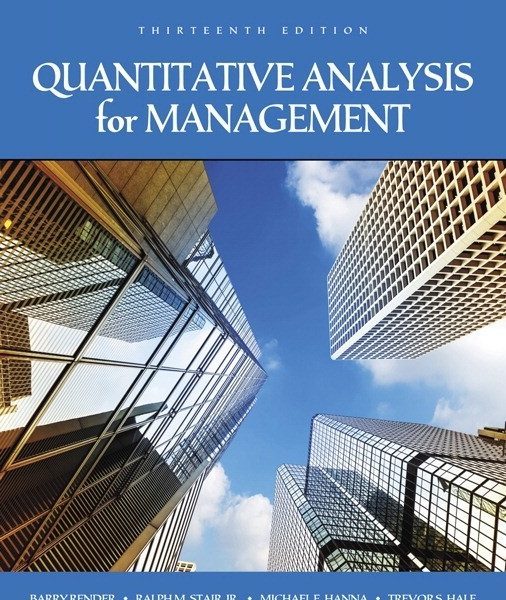
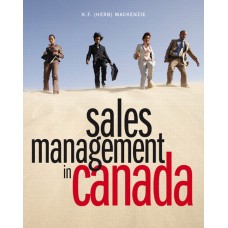
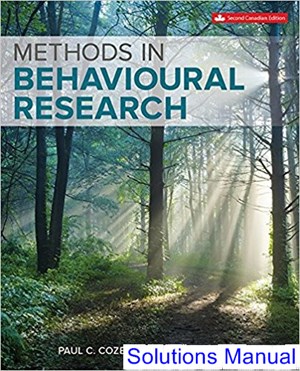
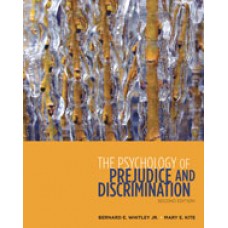
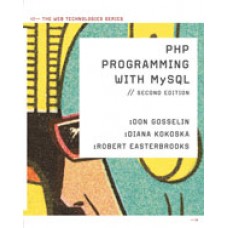
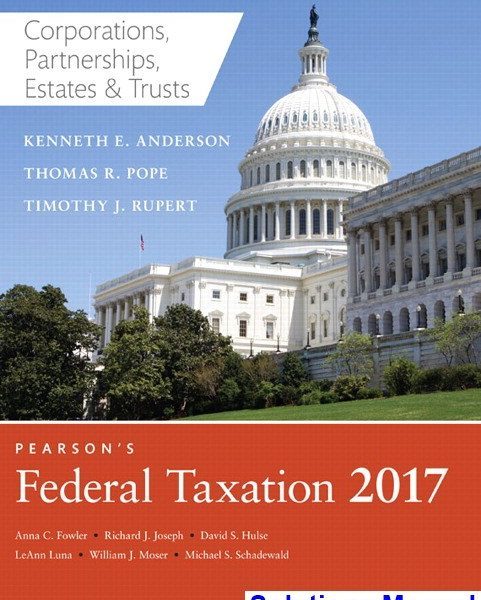
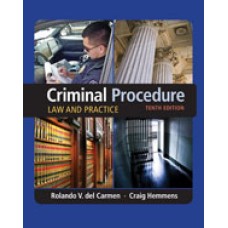

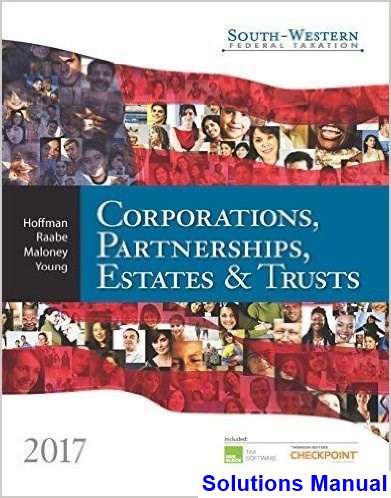
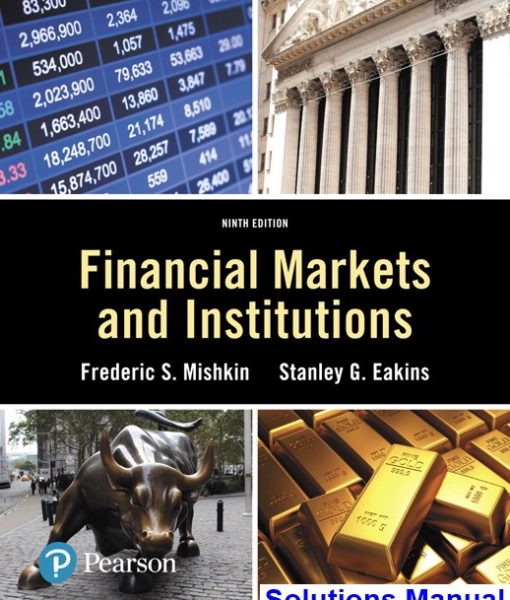
Reviews
There are no reviews yet.